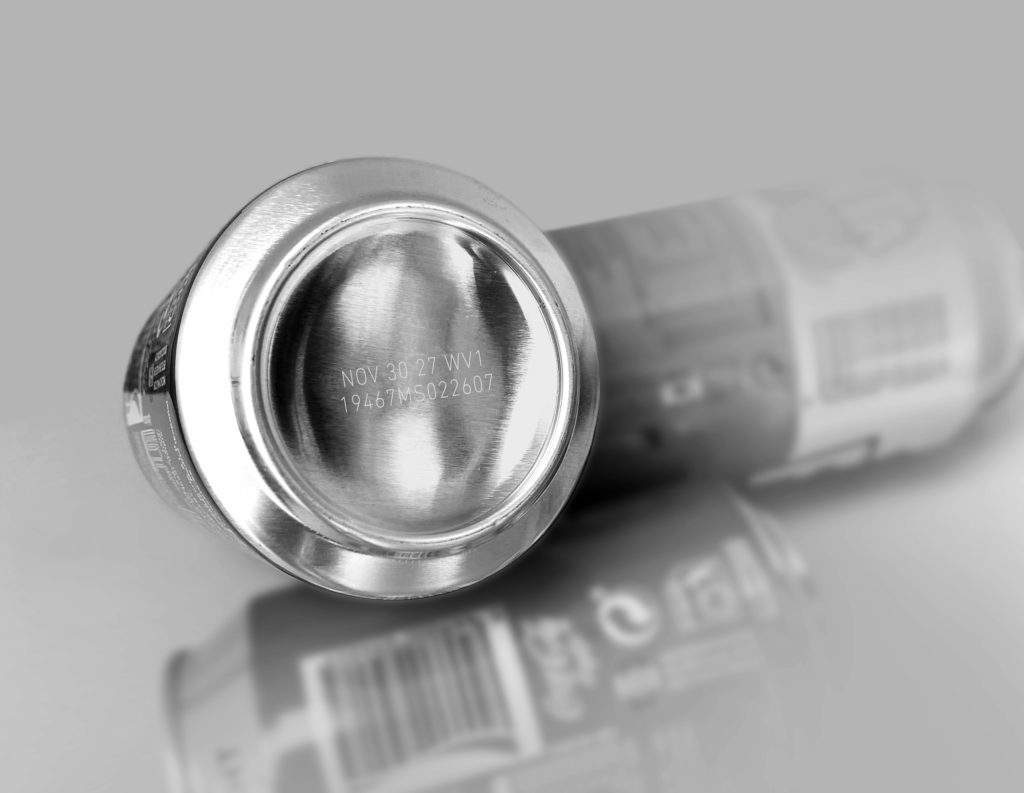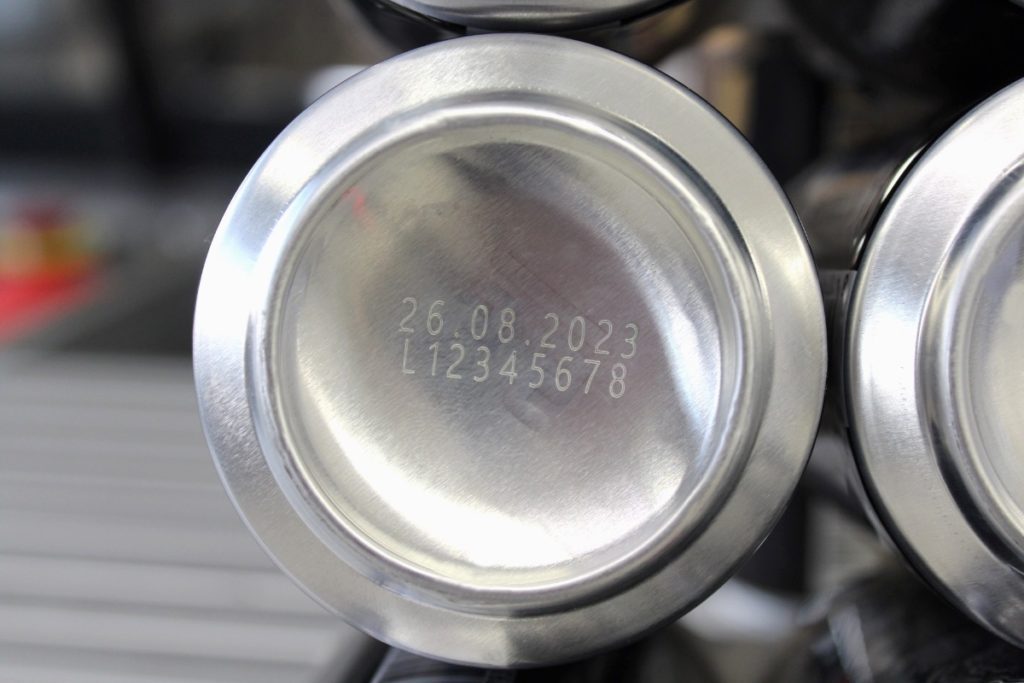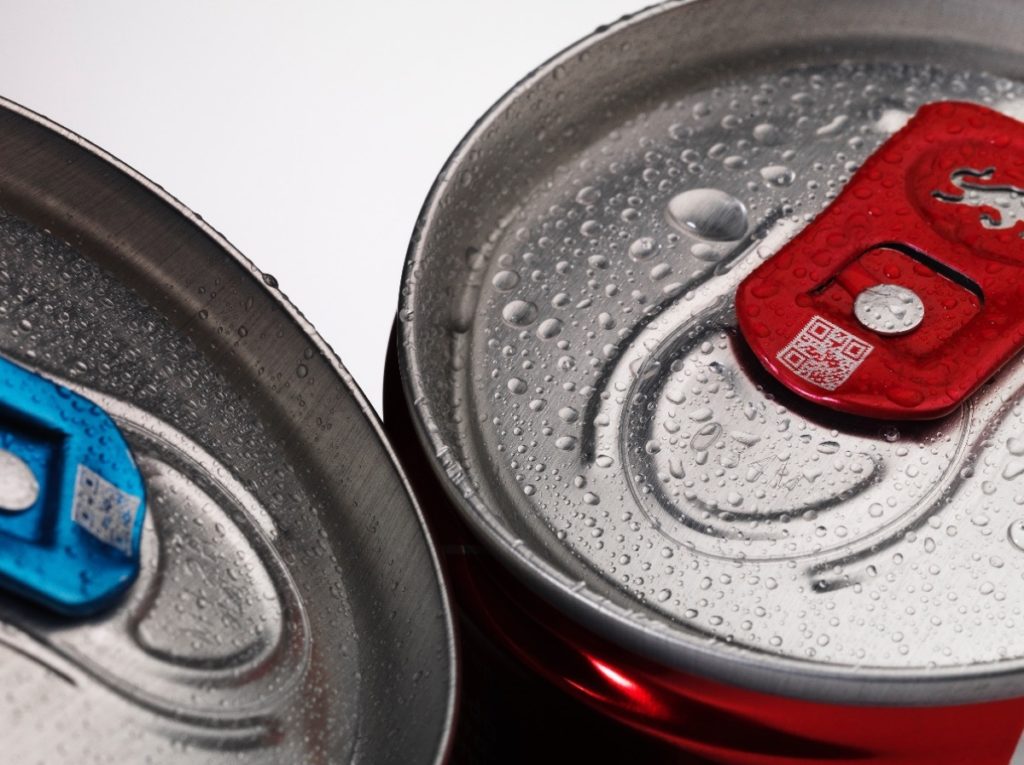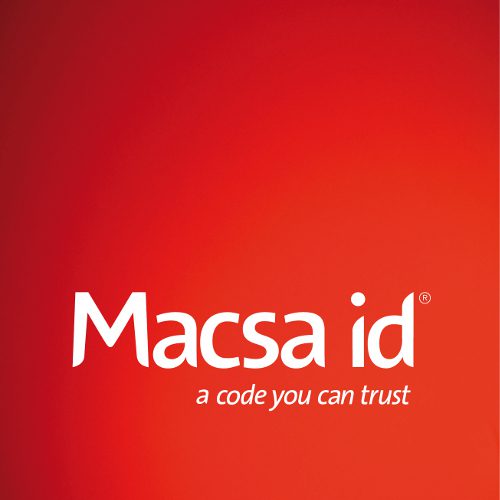The drink can market is in constant growth thanks to various driving factors such as the ease and speed of recycling cans, a determining factor for consumers given current environmental awareness. In this article, discover Macsa id’s specialized lasers for coding and marking cans.
Like other food and drink markets, the can market has the need to mark and code cans with a range of information such as can production date or production batch. It can change depending on the country you are manufacturing.
For many years, continuous ink jet printing technology has been used for marking cans, but recently laser technology has also been implemented in these marking applications.

Lasers for marking and coding drink cans
Table of content
1. The drink can market and marking
2. Characteristics of fiber lasers
3. Can laser marking explanation
4. Macsa’s solution for laser marking cans
1. The drink can market and marking
The drink industry has one of the highest production rates. In most factories, the hourly production of drink cans is around 80,000 cans per hour. Considering it requires coding several lines of text, marking these products is a challenge.
Typically, marking needs on cans involve coding expiry and production dates, batch numbers, but sometimes also include 2D codes such as QR codes or Data Matrix codes. The marking position is usually the base of the can.
Coding requirements in the can market are very demanding. Marking systems must be fast, reliable and high quality.
Thanks to the development of innovative technologies such as fiber laser marking, the solutions offered in this market have been improved. Yet before going into detail with fiber lasers, it is necessary to talk about the technology used to mark drink cans in the past and is which still used today.
Continuous Ink Jet Printing
Continuous ink jet printing is still one of the most widely used systems in the drink industry for can marking.
The different features provided by this technology are:
- It can mark many types of materials including cans.
- Wide range of inks available, also with different ink colors for colored cans.
- Removable inks for returnable containers.
- Adhesive inks for marking on wet containers.
Increasingly, this technology is proving to be sub-optimal because the environment where the cans are produced can affect their readability and adhesion. For this reason, it is common to find duplicate coding on cans, which go through two in-line coding systems, increasing operational costs. (The hot and humid environment of drink plants often affects the legibility and adhesion of the information applied by ink printers. For this reason, manufacturers install two printers on each line so that if one machine fails, the other will still mark a code on the can. In addition to increasing operating costs, when both printers are running the information may be illegible because the two codes overlap).
It should also be noted that, compared to lasers, this technology is not as environmentally friendly.

2. Characteristics of fiber lasers
As mentioned, Laser marking systems have had a recent and incremental impact on the can marking and coding market. The large number of lasers within this industry is not a coincidence, but is due to the large list of features and many advantages offered when compared to other technology. Some of the most important features of marking lasers are detailed and discussed below.
- Fiber lasers. Fiber lasers are used for optimum can marking. The radiation (with a wavelength of 1064 nm) generates an intaglio reaction (engraving) on the aluminum which, although not generating a color change, does produce high visibility and ensures an efficient, reliable and sustainable coding system.
- High marking speeds. Because production rates are so high and a large number of characters must be encoded, the best solution is to use ultra high speed (UHS) and high power equipment from Macsa. Some Macsa lasers can mark more than 170,000 cans per hour (assuming a laser power of 100 W).
- 100×100 Lens. This lens provides a compromise between the energy density needed to generate a durable mark and the depth of focus needed to work on the curved underside of the can without losing coding capability.
- Zero consumables. Laser technology requires no consumables and therefore no need to deal with the management and storage of inks, hazardous solvents and other consumables. In addition, this contributes to being an environmentally friendly machine.
- High quality permanent marking. The lasers guarantee exceptional legibility, traceability and safety, even at very high operating speeds.
- Environmental protection. Macsa lasers can operate in a wide range of temperatures, from 5°C to 40°C. In addition, the external laser housing can be IP55 or IP65 protected. This means that the laser is protected against sprayed water and is dust-tight.
- Minimal maintenance. Maintenance of the lasers is minimal as the only items that need to be checked periodically are the optical components, including the lenses, as well as the air filters. Low maintenance reduces machine operating costs and increases overall equipment efficiency.
- Long life. The internal laser source is long-lasting. It has an MTBF (Mean Time Between Failure) of approximately 100,000 hours, ensuring uninterrupted production, even in the most demanding applications.

3. Laser can marking explanation
The following is a technical explanation of how the laser marking process works on aluminum or tinplate (steel) cans.
Generation and reaction of the fiber laser beam
The marking laser is a device that emits light by means of an optical amplification process based on the stimulated emission of electromagnetic radiation.
The laser, as we have discussed, is electromagnetic radiation and has a wavelength. In this case, it is a Fiber laser and therefore has a wavelength of 1064 nanometers.
When the laser emission hits the can, it generates an intaglio reaction (engraving) that produces a resulting marking of excellent visibility.
The fiber laser for can marking is generated as follows:
- In the laser source, diodes emit photons into the optical fiber doped with an active medium (Ytterbium).
- The amplification process takes place with each collision of the photons with the atoms of the active medium (Ytterbium).
- An element called Master Oscillator pulses the laser to achieve maximum peak output power.
- The laser is then transported to the laser head by standard fiber optics to be collimated in the head to obtain a concentrated output laser beam.

Fiber laser beam steering and control
Once the laser beam is generated, it leaves the laser head but still has to follow a steering and control path. This laser beam path is located inside the marking head and consists of the following stages:
- The beam exits through the laser tube opening and is conducted to the marking surface through the mirrors and focal lens.
- Each movement of the mirrors corresponds to one of the axes (X or Y) and is positioned according to the X-Y coordinates of each of the points of the message to be printed.
- These galvanometric scanners have built-in mirrors that reflect the laser beam to the marking surfaces. The mirrors have a high reflectivity index at the laser wavelength to provide maximum beam power.
- In the case of dynamic marking, the mirrors follow the product as it moves down the production line while the message is being marked.
- Sometimes, in the optical path, there may also be a laser beam expander, which serves to make the laser beam diameter larger/smaller. A 3D system for dynamic control of the Z-axis can also be incorporated.

4. Macsa’s solution for laser marking cans
As a leading company in marking, coding, labeling and traceability, Macsa id adapts its different solutions to the specific needs of each market and each customer.
In this case of the drink can sector, we have implemented the following standard fiber laser marking system, which is modular and can be adapted to the different companies in the sector.
How the system works
The Macsa id fiber laser marking system for standard drink cans is composed of the following devices and systems:
- Adjustable booth height
The booth where the drink cans are marked can be adapted to different transport heights.
The adjustment is manual by means of extending legs (which can be adjusted from the feet or from the upper body). An adjustment of 50 cm is foreseen. In addition, the feet are adjustable at the base to make it level. The assembly of the line is done through a split cabin to facilitate integration.

- Modular cab structure
The booth module is standard and as many modules can be added as required.
The module will always be the same and can be adapted to the application by adding modules as required. The booth is made of grade 316 Stainless Steel. The dimensions are optimized for the transport of the cans.

- Customized I/O side panels
One of the advantages of the machine is that costs are reduced due to the fact that only the panels are customized and also the safety is upgraded to class 1.
The side panels will allow the entry and exit of the assembly to be adapted the customer’s transport. Tunnels can be added to improve safety.

- Cabin capacity
Each cabin module allows the devices to be added according to the customer’s application needs.
The module should at least allow a fiber laser for can marking (SPA F-50 or SPA F-100) and a vision camera for marking verification to be added. The positions must be interchangeable.
- Laser head adjustment
Focal adjustment allows marking of different can sizes. Automatic or manual positioning can be chosen by the customer.
The laser should be adjustable in focal length, manually or automatically, according to requirements (from 90 mm of product up to 250 mm).

- System Control
The system control is adaptable to the customer’s needs, covering the whole range of investments.
The control can be by Panel PC with Integra software (Macsa’s own software for the integration of devices of the same system) or by Laser Touch Screen if only marking is required (Marca Touch software for editing laser messages).
A 500 x 600 mm electrical cabinet must be provided.
In both positions (camera and laser) there must be an emitter-receiver sensor to synchronize the movement of the cans with their marking and verification.
- Closed lower cabinet
Being closed better protects the laser/machine control racks/cabin from water and dust that comes from outside.
The lower booth area shall be enclosed with hood type louvered ventilation.
- Miscellaneous
The machine, as mentioned above, can be customized down to the smallest detail.
The following elements can be added according to the customer’s needs:
- Signaling beacon: This device is a 3-color traffic light that indicates the status of the system at all times.
- Extractor system: A laser marking fume extraction system can be installed. The system will consist of a suction nozzle and an external fume filtering cabin. The nozzle will be attached to the laser module and will be connected to the outside with a flexible tube.
- Viewing window: A window can be installed in the booth module to view the status inside the booth at any time.
- Maintenance doors in the upper module: Doors can be installed in the upper part of the booth to facilitate the handling of the devices when maintenance work has to be done.

If you are looking for the best laser solution, do not hesitate to contact us:

